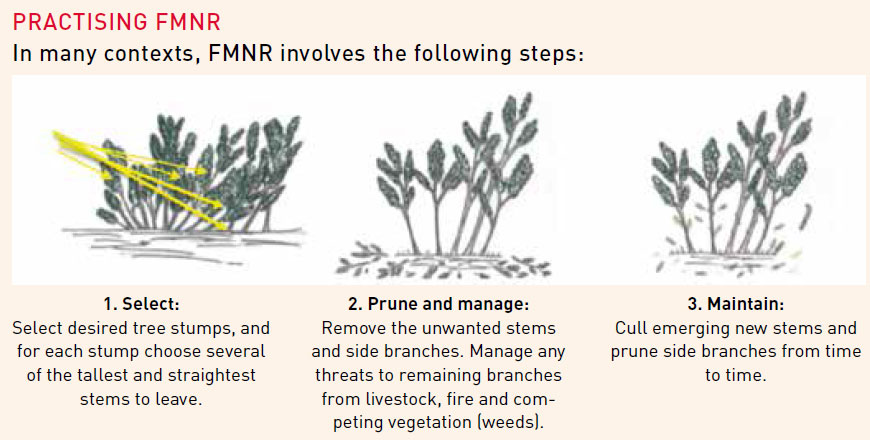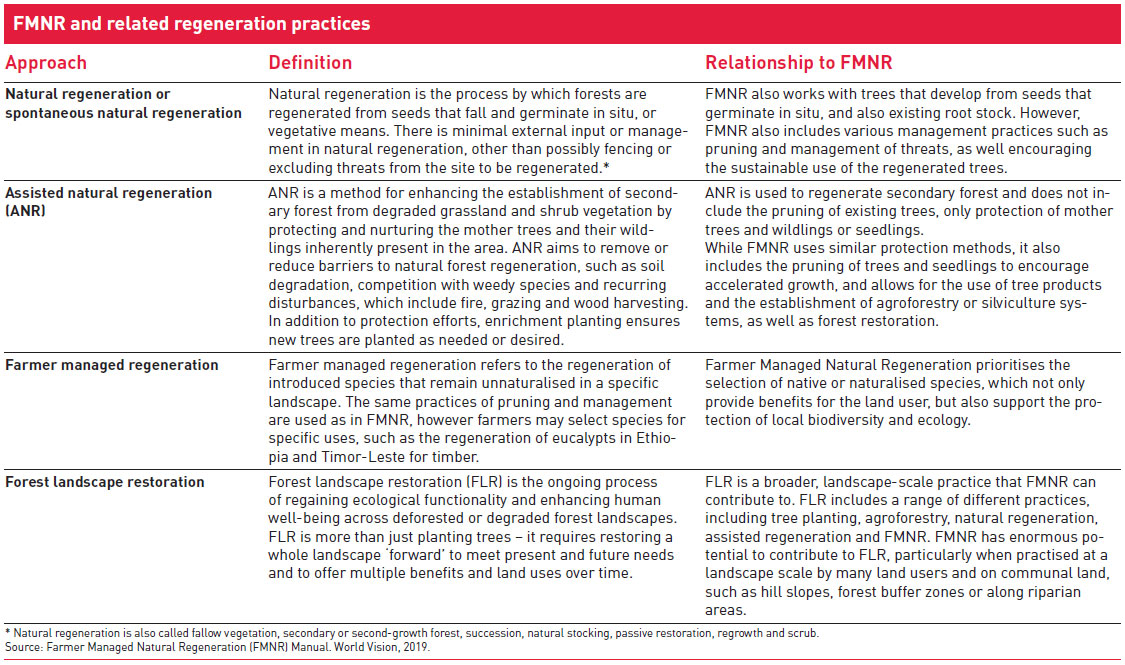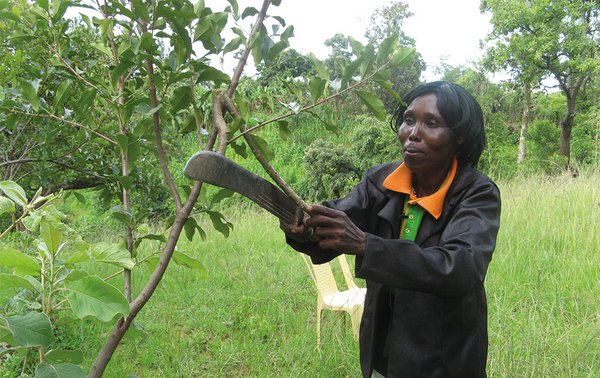First regreen mindscapes, then landscapes
Farmer managed natural regeneration (FMNR) is a simple, low-cost restoration technique enabling farmers to dramatically improve food production and income. On one level, it involves the systematic regrowth and management of trees and shrubs from felled tree stumps, sprouting root systems or seeds. On another level, because FMNR involves behaviour change which can be adopted by whole communities, districts and countries, it is a landscape management practice. To manage emerging trees, certain practices – such as fire use, livestock management, collection of woody biomass and cultivation – must change. When such changes occur at landscape level, there is a shift from land degradation, biodiversity loss and disrupted water and energy cycles to restoration.
Making use of nature’s capacity for self-healing
Seemingly treeless landscapes often contain a vast reserve of living tree stumps with the capacity to regenerate. This can be done at low cost, quickly and simply (with low technology), and at scale. In areas with no or few living tree stumps, there are usually tree seeds in the soil which can be reactivated.
In my work on combating the desertification that started in Niger 35 years ago, learning that many degraded landscapes contain an “underground” forest just waiting to be released led to the realisation that the main constraints to reforestation are not so much technical or financial but social, and are policy-related. While the FMNR pruning technique (see Box below) was co-developed with farmers and honed to meet their needs, much effort also went into raising awareness and popularising the idea.
FMNR goes against the standard practice of clearing fields of all woody vegetation. Yet when farmers can understand that leaving at least some trees to regrow on their land is in their best interests, and that they and their children will have a better future, the rest follows relatively easily. Nature has an enormous capacity for self-healing, if humans take away the constraints and simply allow it to heal. Hence the need to “regreen” mindscapes first – a process akin to turning trees from enemies into friends!

Wide-ranging benefits
By restoring woody vegetation on deforested and often degraded land, FMNR addresses multiple problems simultaneously. These include land degradation and fertility loss, soil erosion, biodiversity loss, food insecurity, fuelwood and building timber shortage, fodder shortage and dysfunctional hydrological cycles (exacerbated flood and drought events, reduced groundwater recharge and the drying up of springs, wells and streams). When done at scale, FMNR contributes to increased groundwater recharge and increased soil moisture, especially when practised in combination with physical soil and water conservation measures.
Since FMNR helps to lift yields and income, it improves livelihoods, food security, resilience and risk reduction. There are documented reports of reduced impact of drought and reduced incidence of flooding. One example is the restoration projects in Humbo and Soddo in Ethiopia. Here, steep hills had been cleared of trees and so when it rained, there was serious flooding and mud/landslides. Restoration of the tree and grass vegetation has not only reduced flooding but reduced temperatures in drought years, increased organic matter (and hence soil moisture holding capacity) and attracted more rain than neighbouring districts. Besides, farmers practising FMNR are more likely to harvest an annual crop in a drought year than their non-practising neighbours. With trees on their farmlands, they also have other options to draw from, including harvesting and selling fuelwood, timber, wild fruits, traditional medicines and fodder. In Niger, for example, farmers rely on their FMNR trees as an emergency reserve which they draw on during food shortage periods – harvesting and selling wood in order to buy grain. In addition, the trees represent a standing fodder reserve, keeping livestock alive in drought.
As land and vegetation restoration is foundational to economic development, FMNR can contribute to diversification of agricultural enterprises, increased investment in agriculture and economic activities, poverty reduction and sustainable wealth creation. Typically, once trees are restored in a landscape, farmers can increase their income from sale of fuelwood, poles and fodder, bee keeping and sale of wild fruits and traditional medicines. In the Humbo case, because of the large increase in availability of fodder, farmers are not only selling grass, some are fattening livestock. This was impossible in past years as there simply wasn’t enough fodder available. The lives of women and children are also made easier as fuelwood is easier to gather and closer at hand. Women have more time to pursue economic and other activities important to them. Their status in the community is often lifted as they participate in group decision-making activities and, sometimes, leadership.
Change human thinking and behaviour, and the trees will grow.
Modelling conducted by Frank van Schoubroeck (2018) on the effect of integrating trees in farming systems in Baringo County, Kenya, found that FMNR lowers the risk of total crop failure, allows for more intensive cow herd management and consequent income generating activities, and reduces farm-level labour to collect fuelwood and stock fodder for animals. As women contribute significantly to these activities, FMNR is likely to reduce women’s labour burden and reward them better for their work.
Since all resources and expertise needed can be found or developed within a community, FMNR does not create dependency. Adoption and spread often continues well beyond the life of any externally funded project. A Ghana study of the economic, social and environmental benefits of FMNR by Peter Western et al. (2013) found a social return on investment ratio of 6:1 by year three (end of the project). Ten years after project closure, the ratio has risen to 43:1 as tree size increases and as the practice continues to be spontaneously adopted.
Well-conceived FMNR projects facilitate good governance, greater collaboration and peace-building. Thanks to these wide-ranging benefits, practitioners often express a heightened sense of well-being and self-worth. They have greater agency in managing available resources. Confidence builds, and they have greater propensity to take calculated risks in investing in improvements to production systems. A common outcome of FMNR interventions is the restoration of hope.
Taking the concerns of farmers seriously
Despite FMNR’s many benefits, resource-poor farmers living in high risk environments have every reason to be wary of adopting new innovations. Initial restrictions on FMNR uptake usually stem from false beliefs, negative attitudes and destructive practices around trees on agricultural and grazing land. Many farmers are convinced that trees grow slowly and therefore will not benefit them in the short or intermediate term. Often they believe that trees compete with crops and pasture and must be removed. It is important to acknowledge this mindset, but also to invite farmers and communities to come on a journey of discovery and learning, testing on a small scale and learning through observation, adaptation and collaboration. For especially when growing trees from mature stumps, they grow amazingly quickly – in Niger, even 1.5 to 2 metres in the first year! So one of the big hurdles is to convince the farmers that they will not need to wait a decade to benefit from their work, and in fact measurable benefits, though small, are obtained in the first year – from the pruned branches for fuelwood, from the leaves enriching the soil, from habitat for pollinators and insect predators, from slightly reduced wind speed and temperatures, and, significantly, in dry countries from hydraulic lift, which increases moisture in surface soil layers.
Very often, well intentioned government policies to protect trees have the opposite effect. In many countries, the government owns all tree resources. If individuals are allowed to harvest trees at all, they must go to the centralised forestry department to purchase a permit. Fines and even imprisonment for cutting trees can actually be powerful incentives for farmers to surreptitiously remove all trees from their land. This not only avoids the possibility of punishment; it stops others from taking what farmers consider as rightfully theirs. Today, organisations such as The World Agroforestry Centre, The World Resources Institute and World Vision advocate governments to create enabling policies that empower and equip communities and individuals to responsibly manage the natural resource base – and to sustainably benefit from it.
Interestingly, perhaps because of the simplicity, low cost and “farmer managed” nature of FMNR, governments, donors, experts and implementing agencies may discount its value as a restoration practice. Even at this level, regreening of mindscapes may be required.
A co-learning journey
Over the past years, World Vision has introduced the FMNR concept in 27 countries. In the course of our activities, we have learnt the following key lessons:
- It is important to work with farmers, communities and authorities, building on what they know already. FMNR implementation is a co-learning journey in which both promoter and adopter learn new skills and ways of applying restoration principles.
- Stakeholders need to understand the value of trees and how they will benefit. “Mindscape regreening” sets the scene for behaviour change, leading to landscape regreening.
- Mechanisms to adequately deal with constraints such as negative peer pressure, tree theft and fire or livestock damage must be in place.
- Enabling policies that give farmers ownership of, or at least user rights to, trees on their land provide powerful incentives for farmers to adopt agroforestry and FMNR. Farmers can implement FMNR with reasonable confidence that they will benefit from their work.
- Farmers must be able to benefit from their trees, not only directly through the goods and services they provide for domestic consumption, but financially through the sale of timber and non-timber tree products.
- Formation and capacity building of FMNR practitioner groups provides strength in numbers and mutual support.
- Co-creation by stakeholders of by-laws for tree and land management and a locally managed compliance mechanism give farmers greater security.

Tony Rinaudo is Principal Natural Resources Advisor at World Vision Australia. For his decades of work in combating desertification, he received the Rural Livelihood Award in 2018.
Contact: Tony.Rinaudo@worldvision.com.au
References and further reading
Van Schoubroeck, Frank (2018). Integrating trees in farming systems in Baringo County, Kenya reduced variability of food and fodder production.
Western, Peter et al. (2013). Talensi Farmer-Managed Natural Regeneration Project, Ghana Social Return on Investment Report.
https://fmnrhub.com.au/wp-content/uploads/2013/10/SROI-Report_Low-Resolution.pdf
FMNR Field Manual (2019):
https://fmnrhub.com.au/wp-content/uploads/2019/03/FMNR-Field-Manual_DIGITAL_FA.pdf
https://fmnrhub.com.au/humbo-fifteen-years-later/#.XdYRbegzY2w
https://fmnrhub.com.au/humbo-fifteen-years-later/#.XdYRbegzY2w
https://fmnrhub.com.au/plenty-times-scarcity/#.XdYRsegzY2w
https://fmnrhub.com.au/farmtreetool-explains-less-grass-means-cows-farms-kenya/#.XdYSmegzY2w
http://fmnrhub.com.au/desperation-comes-hope-fmnr-somaliland/#.WIWOaVV97IU
http://fmnrhub.com.au/fmnr-brings-economic-empowerment-women-kenya-nancys-story/#.WIWOyFV97IU
http://fmnrhub.com.au/fmnr-kenya-unearths-opportunities-farmers/#.WIWO31V97IU
http://fmnrhub.com.au/small-bushes-big-trees-grow/#.WIWO9lV97IU





Add a comment
Be the First to Comment